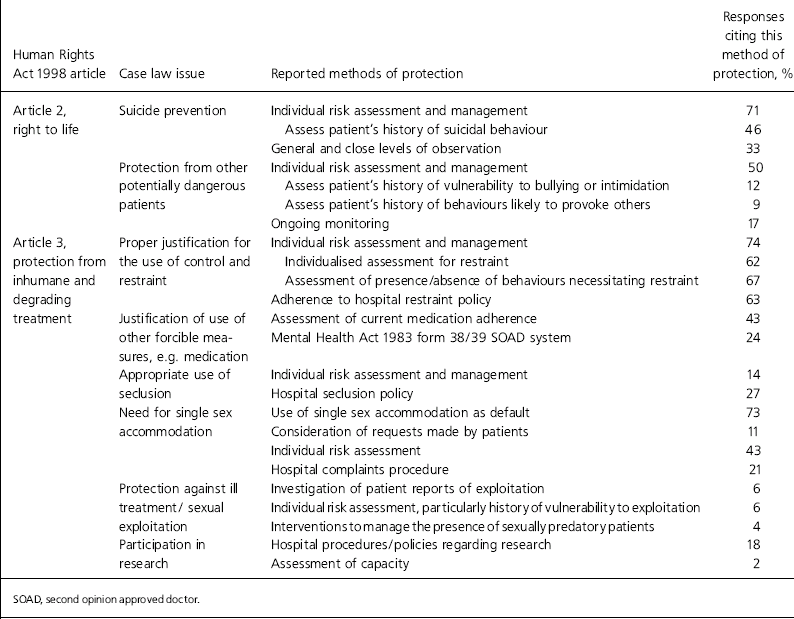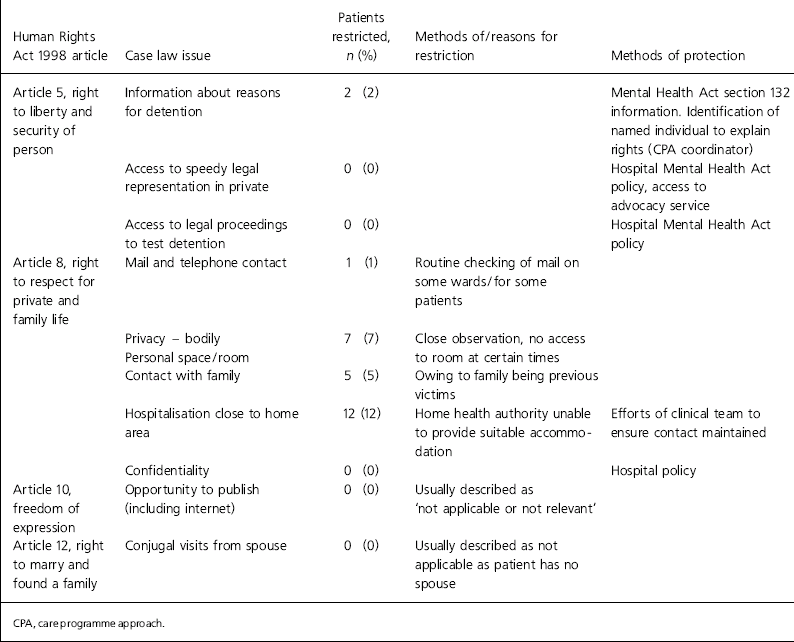The Human Rights Act 1998 was incorporated into UK law in October 2000 and ratified the rights outlined in the European Convention on Human Rights. There has been a recent focus on new mental health detention legislation and the Convention right to liberty (Reference SugarmanSugarman, 2002), but of course all the rights of the Convention apply to those in psychiatric care. The Act applies to employees of public authorities, including hospitals providing care under the Mental Health Act 1983. Patients may now attempt to enforce their rights in the domestic courts (Reference MacGregor-Morris, Ewbank and BirminghamMacgregor-Morris et al, 2001). However, there is little evidence, as yet, of an upsurge of legal challenges (Reference BowenBowen, 2004).
Rights conferred under the Act are ‘absolute’ or ‘ qualified’. Absolute rights cannot be infringed by any public authority, however necessary this may appear. Qualified rights may be restricted proportionately to promote specific, legitimate aims, including public safety. Crucially, the Act requires public authorities to actively promote Convention rights.
Limited evidence is available on clinicians’ knowledge of the Act, its implementation, or the active promotion of rights in psychiatric practice. Passmore & Leung (Reference Passmore and Leung2003) reported that psychiatrists have good overall knowledge of the Act, but there may be a gap between the awareness of senior clinicians and implementation by clinical teams. Similarly, the British Institute of Human Rights (2002) reported good awareness of the existence of the Act among providers of services for people with disabilities, but little knowledge of how this relates to practice.
In the current study we explored how the Act applies in practice by investigating the understanding within clinical teams of the statutory and local devices that will aid protection and, where appropriate, justify the proportionate restriction of their patients’ human rights.
Method
Study design
In order to audit our clinical practice, we sought written, narrative descriptions of the proportionate restriction of the qualified human rights of patients and the protection of both their absolute and qualified human rights utilising an open-response questionnaire. We reviewed the literature and relevant case law to generate pertinent issues (see Tables 1 and 2). For each identified issue we asked how protection for each patient was ensured and, for qualified rights, whether any proportionate restrictions were in place for this patient. Our instruction was for the questionnaire to be completed by each patient's care programme approach (CPA) coordinator in consultation with the multidisciplinary team. Questionnaires were collected together with anonymised patient details (gender, age, length of hospitalisation, legal status).
Table 1. Reported methods of protection of absolute human rights

| Human Rights Act 1998 article | Case law issue | Reported methods of protection | Responses citing this method of protection, % |
|---|---|---|---|
| Article 2, right to life | Suicide prevention | Individual risk assessment and management | 71 |
| Assess patient's history of suicidal behaviour | 46 | ||
| General and close levels of observation | 33 | ||
| Protection from other potentially dangerous patients | Individual risk assessment and management | 50 | |
| Assess patient's history of vulnerability to bullying or intimidation | 12 | ||
| Assess patient's history of behaviours likely to provoke others | 9 | ||
| Ongoing monitoring | 17 | ||
| Article 3, protection from inhumane and degrading treatment | Proper justification for the use of control and restraint | Individual risk assessment and management | 74 |
| Individualised assessment for restraint | 62 | ||
| Assessment of presence/absence of behaviours necessitating restraint | 67 | ||
| Adherence to hospital restraint policy | 63 | ||
| Justification of use of other forcible measures, e.g. medication | Assessment of current medication adherence | 43 | |
| Mental Health Act 1983 form 38/39 SOAD system | 24 | ||
| Appropriate use of seclusion | Individual risk assessment and management | 14 | |
| Hospital seclusion policy | 27 | ||
| Need for single sex accommodation | Use of single sex accommodation as default | 73 | |
| Consideration of requests made by patients | 11 | ||
| Individual risk assessment | 43 | ||
| Hospital complaints procedure | 21 | ||
| Protection against ill treatment/ sexual exploitation | Investigation of patient reports of exploitation | 6 | |
| Individual risk assessment, particularly history of vulnerability to exploitation | 6 | ||
| Interventions to manage the presence of sexually predatory patients | 4 | ||
| Participation in research | Hospital procedures/policies regarding research | 18 | |
| Assessment of capacity | 2 |
Table 2. Reported methods of protection and restriction of qualified human rights

| Human Rights Act 1998 article | Case law issue | Patients restricted, n (%) | Methods of/reasons for restriction | Methods of protection |
|---|---|---|---|---|
| Article 5, right to liberty and security of person | Information about reasons for detention | 2 (2) | Mental Health Act section 132 information. Identification of named individual to explain rights (CPA coordinator) | |
| Access to speedy legal representation in private | 0 (0) | Hospital Mental Health Act policy, access to advocacy service | ||
| Access to legal proceedings to test detention | 0 (0) | Hospital Mental Health Act policy | ||
| Article 8, right to respect for private and family life | Mail and telephone contact | 1 (1) | Routine checking of mail on some wards/for some patients | |
| Privacy — bodily Personal space/room | 7 (7) | Close observation, no access to room at certain times | ||
| Contact with family | 5 (5) | Owing to family being previous victims | ||
| Hospitalisation close to home area | 12 (12) | Home health authority unable to provide suitable accommodation | Efforts of clinical team to ensure contact maintained | |
| Confidentiality | 0 (0) | Hospital policy | ||
| Article 10, freedom of expression | Opportunity to publish (including internet) | 0 (0) | Usually described as ‘not applicable or not relevant’ | |
| Article 12, right to marry and found a family | Conjugal visits from spouse | 0 (0) | Usually described as not applicable as patient has no spouse |
Participants
Questionnaires were sent to seven medically led multidisciplinary care teams employed in the 118-bed adult mental health division of St Andrew's Hospital, Northampton, a charitable provider of specialist mental healthcare and rehabilitation. Our instruction was for participation to be a team exercise, with team views summarised on open-response questionnaires by CPA coordinators. The CPA coordinators summarising the team view included 62 psychiatric nurses and five occupational therapists.
Data analysis
Data were analysed by quantitative content analysis (Reference NeuendorfNeuendorf, 2001). Written, narrative data were screened to generate broad categories of rights restriction and protection. We subsequently assigned narrative data from all questionnaires into these categories.
Results
Questionnaires were collected for 102 of 118 (86.4%) patients; 71 patients (69.6%) were male and 31 (30.4%) female. The mean length of in-patient stay was 48.9 months; 94 (92.2%) patients were detained.
Table 1 shows how absolute human rights were largely described as being protected through individualised risk assessment and management. Few details were given of how specifically this might protect rights. In addition, local policy was cited as protecting patients against unjustified use of restraint and seclusion. National legislation, mainly the Mental Health Act 1983, was viewed as one of two main methods of protecting against forcible measures such as tranquillisation.
Table 2 illustrates the narrow extent to which respondents viewed the qualified human rights of patients as being restricted. The most frequent restriction was reported to be hospitalisation away from the patient's home area (12 patients). Smaller numbers of patients were reported to have their rights restricted in terms of privacy (7 patients), contact with family (5 patients) and mail and telephone contact (1 patient). Again, local policy and national legislation were among the most frequently cited methods of protection, although individualised risk assessment was not.
Discussion
We studied the understanding of multidisciplinary teams of how human rights are protected and, for qualified rights, restricted in secure psychiatric care. Absolute rights were largely described as being protected by existing UK legislation, organisational policy, individualised risk assessment and risk management. Qualified rights were rarely viewed as being restricted in this population of mostly detained patients.
It has previously been suggested that the Human Rights Act 1998 would have an impact on suicide prevention policies (Reference Persaud and HewittPersaud & Hewitt, 2001) and lead to a greater emphasis on risk assessment, which seems consistent with our findings. There is an identified need for more regular training in risk assessment for staff, but also explicit guidance on staffing levels and observation (Reference HewsonHewson, 2000). Our clinicians focused on risk management, but they did not cite training or staffing issues. Although this might not be an area of concern for them, their understanding of the relevance of human rights law to clinical practice may be limited.
Our study shows that practitioners naturally refer to the Mental Health Act 1983 on issues of enforced medication. The focus on risk management was accompanied by little on patients’ positive capacity, or a person's previously expressed preferences (Reference Wong, Clare and GunnWong et al, 1999), suggesting the Mental Capacity Act 2005 has had little impact so far. There was similarly little on positive protections under the Care Standards Act 2000 (Reference JonesJones, 2004), or the CPA in protection of article 8 rights, even though this is routinely addressed. Restrictions of article 10 (patient access to published material) and article 12 (conjugal visits) rights were also not raised, although these issues can clearly lead to complex ethical dilemmas (e.g. Reference Persaud and HewittPersaud & Hewitt, 2001). Our staff do appear to think of human rights in a narrow ‘risk assessment’ way, separate from much of their more enabling clinical work.
Potential criticisms
The protection of human rights in psychiatric care is currently largely undescribed, necessitating an exploratory methodology to map the area. The method of data collection utilised in this study therefore imposes some limitations on its findings: themes were generated from written, narrative data provided and we did not offer prompts as to ‘correct’ answers. In addition, we cannot gauge the degree of multidisciplinary communication, although our instruction was for completion to be a team exercise within our medically led teams. We did not attempt to assess the knowledge level of particular professions, as the data are based on the team view as perceived by CPA coordinators. However, evidence suggests that different professional groups may view certain legal applications quite differently (e.g. Reference PeayPeay, 2003), and further research could investigate how this affects team decision-making in relation to human rights protection. Finally, the study was undertaken in a psychiatric hospital in the independent sector and findings cannot necessarily be generalised to National Health Service (NHS) settings, although most of our clinical staff move between the NHS and the independent sector at some point in their careers.
Implications
The challenge of modern healthcare governance in a complex regulatory environment is to integrate statutory requirements of different kinds into a coherent body of clinical policy and best practice. At present our clinical policies have become dominated by the requirement of the Healthcare Commission under the Care Standards Act 2000 and the Mental Health Act 1983, with associated instruments such as the National Minimum Care Standards and the Mental Health Act Code of Practice. The Human Rights Act 1998 is a framework of principle against which other statutes are now measured. There is a clear need to develop a culture of healthcare governance which has human rights at its heart, explicitly expressed throughout clinical policy, training and audit.
Declaration of interest
None.





eLetters
No eLetters have been published for this article.